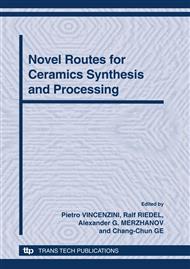p.352
p.358
p.364
p.370
p.374
p.383
p.392
p.396
p.402
High-Strength Reaction-Sintered Silicon Carbide for Large-Scale Mirrors - Effect of Surface Oxide Layer on Bending Strength
Abstract:
Reaction-sintered silicon carbide of 800 MPa class bending strength had been newly developed. The developed silicon carbide showed good rigidity, high thermal conductivity, and high density, like a conventional sintered silicon carbide. The developed silicon carbide is one of the most attractive materials for large-scale ceramic structures because of its low processing temperature, good shape capability, low-cost processing and high purity. We had fabricated some lightweight space mirrors, such as a high-strength reaction-sintered silicon carbide mirror of 650 mm in diameter. In this study, experiments were conducted to investigate the effect of annealing on the bending strength of high-strength reaction-sintered silicon carbide. The annealing heat treatments were carried out at 1073 K, 1273 K, and 1473 K in an air atmosphere. The maximum bending strength of 1091 MPa at room temperature was achieved by the annealing heat-treatment at 1273 K for 10 h in air. We confirmed that annealing heat treatment was effective to improve the bending strength of reaction-sintered silicon carbide by inducing compressive residual stress at the surface oxide layer.
Info:
Periodical:
Pages:
374-382
Citation:
Online since:
October 2010
Authors:
Price:
Сopyright:
© 2010 Trans Tech Publications Ltd. All Rights Reserved
Share:
Citation:


